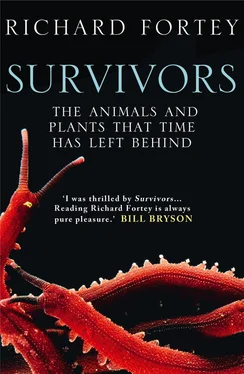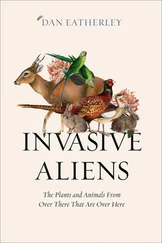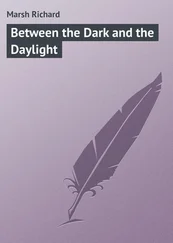Stromatolites are found way back into the Archaean. The oldest ones of all are almost miraculous survivors found on the scraps remaining today of the most ancient continents. Fossils dated at 3.5 billion years old have been found in the Apex Chert in Western Australia, *and in Swaziland. It is hardly possible to imagine such antiquity. I have the same trouble trying to grasp the number of stars in the Milky Way, for the mind soon loses its normal frame of reference when the figures get so large. I can probably do no better than echo the words of the pioneer geologist John Playfair in 1788, when he became convinced of the reality of the vast age of the earth: ‘the mind seemed to grow giddy looking so far into the abyss of time’. Nonetheless, it is important to at least get a feeling for this ‘abyss’, an intuition of its magnitude, because it shows just how long it has taken for life to arrive where it is today. The two stories of life, and the earth itself, have been intimately intertwined for billions of years.
Stromatolites began in the Archaean as relatively simple domes, but later they evolved into a number of different forms. Some of the more distinctive shapes have been dubbed with Latin names, just as if they were organisms in the conventional sense (Pilbaria perplexa and the like). As we have seen, they are actually collaborations between several organisms, so such an approach does not fit in with normal biological procedure. However, it is useful to have a way to refer to different shapes and forms, and some of the names have achieved wide currency. In the far reaches of the Precambrian, stromatolites could grow in a wider range of marine environments than they do now, and this may partly account for some of their different shapes. In deeper or calmer water, for example, it was possible for relatively delicate, branching, even candelabra-like forms to grow. In complete contrast, one of the most distinctive varieties produced massive cone-shaped bodies that could grow to be tens of metres high. These microbial behemoths have received the appropriate name Conophyton (‘cone plant’). They have been memorably described as making outcrops in the field look like a series of rocket launchers placed side by side: they must have taken many centuries, even millennia, to grow. The vocabulary used to describe different kinds of stromatolites gives some indication of their variety of form; they have been compared with fingers, fists, cauliflowers, columns, spindles, trees, mushrooms, kidneys. Given time enough these most simple organisms could produce an art gallery’s worth of shapes. Nature was patently a sculptor from the first. The view from Hamelin Pool was, it now transpires, only a partial glimpse of a richer, but now vanished stromatolitic world.
The controls on stromatolite growth were probably quite simple. The growing surface film was attracted towards the sun, while the supply of calcium carbonate from seawater dictated the dimensions of the layers produced. A group of Australian physicists have developed computer models that ‘grow’ stromatolites by playing around with these simple elements. Conophyton emerges naturally as a shape in response to strong solar attraction; prokaryotic life, it seems, simply could not help building regular structures. Where there’s life there’s architecture. But there is also good evidence that the variety and complexity of stromatolites increased during their extraordinarily long tenure of the earth’s seas. The few kinds of simple domes and cones that dominated their first billion years, during the Archaean, were supplemented by dozens of additional shapes during the Proterozoic, when branched structures and pleated columns on many different scales appeared. The first occurrence of particular stromatolites has even been used broadly to subdivide this long period of time. They probably achieved their greatest variety about a thousand million years ago, but still long before the emergence of large animals, even the strange Ediacaran ones. Many early stromatolites were fully submarine, rather than living between the tides. Their living analogues have been found in the Bahamas near Exuma Island, hidden in marine channels. Here, these large, lumpy columns rising from a lime-mud sea floor probably provide a closer match to many Proterozoic environments than does Shark Bay. The biofilm forming the living skin is known to be a complex microbial community, and much more than just a photosynthesising surface. Several other kinds of bacteria have their homes there, some with the capacity to ‘fix’ nitrogen, like the little nodules harbouring bacteria that grow on the roots of beans and contribute to soil fertility. These kinds of bacteria work at night, when the cyanobacteria are ‘sleeping’. Once again, the mat is a whole ecology, a world measured in millimetres.
As for the fossils of the organisms that made the Precambrian mounds, the apparent absence of which so perplexed Charles Darwin and his contemporaries, well, they were lurking there all the time; it is just that they were very small. The cherts, like those tucked among the limestone rocks on Spitsbergen, held the secret. In some cases such siliceous rocks were formed early enough to petrify the fine threads and other cells making up the ancient biofilm. The process is somewhat analogous to that involved in making artificial resin souvenirs in which butterflies or scorpions are preserved, colour and all, which then lurk on the mantelpiece forever. Silica petrifactions were already well known from higher in the geological column, even preserving tree trunks down to the last cell. Considering that the dimensions of the Precambrian fossils are often measured in a few thousandths of a millimetre, the preservation of their cell walls is remarkable, almost miraculous. However, when very thin sections were made of the right Precambrian cherts they became transparent; these preparations were then examined under the microscope and revealed the unmistakeable imprint of life. The discovery was reported in detail in 1965 by the resplendently named American scientist Elso Sterrenberg Barghoorn Jr based on fossils obtained from the Gunflint Chert, a rock formation exposed along the northern shores of Lake Superior. Barghoorn’s co-author, Stanley Tyler, had previously recognised fossil stromatolites preserved in rather beautiful red jaspers (an iron-rich form of silica). At the edge of the Canadian Shield, the Gunflint Chert was one of those special survivors that had escaped the subsequent adventures of our mobile planet, fortuitously frozen in its own ancient time. At 1.9 billion years old, the fossils of the Gunflint Chert lie well down in the Palaeoproterozoic. Among the organic remains seen in thin sections of the chert, the commonest are probably thin threads not unlike those so abundant in living mats and biofilms. Some of these show the kind of transverse striping that are typical of some ‘blue greens’; interestingly, the threads are narrower than they were later in the Precambrian (and narrower still than they are today). They are accompanied by a range of other tiny organisms, some generalised rod-like bacteria, others more distinctive, like the spherical Eosphaeria with its cell walls apparently divided into compartments, and the enigmatic Gunflintia. Palaeontologists continue to argue about the biological identity of some of these fossils, although it is beyond doubt that ‘blue greens’ were certainly present among them, but the important point is surely that this is an early community, already divided into different biological ‘trades’. The kind of prokaryote collaboration happening today was already happening then. Stromatolites were indeed true survivors.
But back in the 1960s, the fossil search was on! The world was scoured for younger, older, similar or, in particular, new and unnamed Precambrian small fossils. Africa, especially Namibia and Swaziland, was mapped and investigated; Australia, especially Western Australia, was crawled over; the Old World was looked at again, and much of the New World was looked at with new eyes. Precambrian fossils turned out to be very widespread, and new discoveries were nearly always heralded by someone spotting stromatolites in the field, which hinted at what might yet be found at the microscopic scale. Geologists’ boots tramped up wadis in deserts, their hammers whacked at Arctic cliffs, and their hand lenses focused on limestones outcropping deep in the Siberian taiga. These last devoted geologists bore the scars of marauding mosquitoes for weeks. Then by dissolving Precambrian shale in hydrofluoric acid still other microfossils with organic walls were extracted, to be studied in detail on microscope slides. University departments hired staff, and the growth in knowledge was exponential. Many of the famous names in early evolution were students of, or collaborated with, Elso Barghoorn. Andrew Knoll was among them. Bill Schopf, an equally grand figure at the University of California, Los Angeles, is now the elder statesman of the Barghoorn disciples, and did much to push the record of life and its fossils further back, into the Archaean.
Читать дальше












